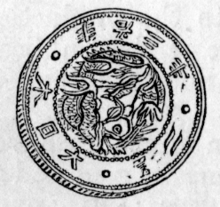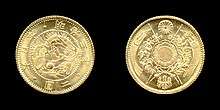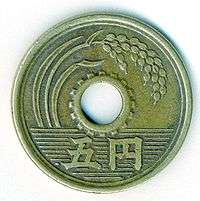2 yen coin
The 2 yen coin (二圓金貨) was a short lived denomination of Japanese yen. During the first year of mintage in 1870, hundreds of thousands of these new coins were struck. These figures dropped off sharply as the Japanese government looked towards silver as a trading commodity. The supply of gold bullion had also dwindled causing the demand for these coins to outpace the supply available. The public hoarded two yen coins along with other denominations of gold causing them not to circulate during the mid 1870s. Japan eventually obtained a supply of gold bullion towards the end of the century, but this came too late for the two yen coin which was last minted in 1892. Almost one hundred years later the two yen coin was officially demonetized. While not in circulation any more, these coins are bought and sold by numismatics for academic study, and by those with a hobby.
Japan | |
| Value | 2 Japanese Yen |
|---|---|
| Edge | Smooth |
| Shape | Circular |
| Composition | 90% Gold 10% Copper |
| Years of minting | 1870–1892 |
| Obverse | |
 | |
| Design | Dragon figure surrounded by legend.[lower-alpha 1] |
| Reverse | |
 | |
| Design | Emblem of the Imperial family. |
History
The Japanese mint was first opened in December, 1870 at Osaka. Each two yen coin was set at 900 fineness with a weight of 51.44 grains. Gold bullion was delivered from private Japanese citizens, foreigners, and the Japanese government.[1] The overall production of gold coin declined by the mid 1870s as the Japanese government established a gold and silver double digit system. Meji's decree proclamation No. 27 set the gold and silver price ratio to 1: 16.17.[2] With the opening of silver to trade came the trade dollar, Japan issued its own version in 1875 in order compete with other currencies such as the United States.[3] The low mintages of the two yen coin in the latter years may also be attributed to a lack of gold bullion available, as previously minted gold coins were hoarded by the public and did not circulate.[4] It was reported that by 1896 a total of 151,210,000 silver pieces of all denominations of yen had been struck since 1870, verses 2,037,055 for gold.[3]
Japan officially went onto the gold standard in 1897 from reserves obtained after the first Sino-Japanese War.[3][5] New laws were passed that abolished the Japanese silver trade dollar, as well as the one silver yen piece. The two yen gold coin was also not among the new coins scheduled to be minted.[3] Two yen gold coins were finally abolished as legal tender in 1988, by this time the exchange rate for gold coins to Japan's modern circulating currency as a whole was zero.[6]
Circulation figures

Meiji
The following are circulation figures for the two yen coin, all of which were minted between the 3rd, and 25th year of Meiji's reign. The dates all begin with the Japanese symbol 明治 (Meiji), followed by the year of his reign the coin was minted. Each coin is read clockwise from right to left, so in the example used below "九" would read as "year 9" or 1876. It is unknown if genuine coins dated 1874 even exist as they remain "unverified". Two yen coins were struck in 1892, but none were released for circulation.
- "Year" ← "Number representing year of reign" ← "Emperors name" (Ex: 年 ← 九 ← 治明)
| Year of reign | Japanese date | Gregorian date | Mintage |
|---|---|---|---|
| 3rd | 三 | 1870 | 883,293[7] |
| 7th | 七 | 1874 | Unverified[8] |
| 9th | 九 | 1876 | 178[8] |
| 10th | 十 | 1877 | 39[8] |
| 13th | 三十 | 1880 | 87[8] |
| 25th | 五十二 | 1892 | Not circulated[8] |
Collectibility
The only collectable coins of this series are first year issues dated 1870 (year 3), all other dates are considered to be extremely rare. The date 1880 (year 13) has only ten known surviving examples out of a total mintage of less than 100.[9][10] At least two of these coins have sold at auction; one in 2008 for $299,595 (USD), and another in 2011 for $75,000 (USD).[10][11] Other dates such as year 9 (1876) have also appeared, listing at $144,000 (USD) in a 2016 Japanese auction.[12]
See also
Notes
- In numismatic terminology, a "legend" is a formal inscription found around the margin of a coin.
References
- Hisamitsu Shigehira (1976). Monogatari Monogatari. Mainichi Shimbun. pp. 176–178.
- Horie Kiichi (1927). Monetary Theory. Togoterikan. pp. 575–578. Retrieved August 7, 2018.
- Sir Robert Harry Inglis Palgrave (1913). Dictionary of political economy, Volume 3. Macmillan and Co. pp. 683–684. Retrieved August 6, 2018.
- Toshi Aoyama (1982). History of Japanese coins and collection guide. Bonanza. pp. 182–183.
- Metzler, Mark (2006). Lever of Empire: The International Gold Standard and the Crisis of Liberalism in Prewar Japan. Berkeley: University of California Press. ISBN 0-520-24420-6.
- Mint Bureau (1997). Mint Bureau 125 Year History.
- "Japan 2 Yen Y# 10 Yr.3(1870)". Numismatic Guaranty Corporation. Retrieved August 3, 2018.
- "Japan 2 Yen Y# 10a". Numismatic Guaranty Corporation. Retrieved August 3, 2018.
- "旧2圓金貨の価値と概要". kosenkaitori.info. Retrieved August 6, 2018.
- "Japanese 1880 ¥2 Gold Coin Auctioned for ¥32.1 Million". Coinnews.net. February 25, 2008. Retrieved January 21, 2020.
- "明治的2日圓金幣". antique.office-aikawa.com. Retrieved August 6, 2018.
- "环球拍卖网第五次拍卖开始预展". weixin.uteng.com. Archived from the original on August 9, 2018. Retrieved August 8, 2018.
